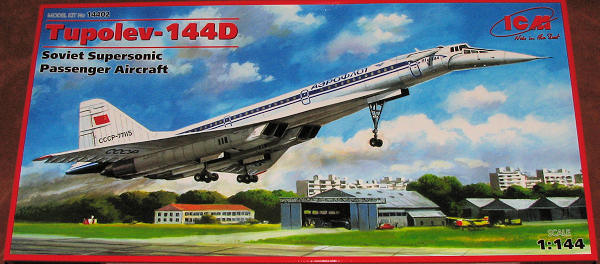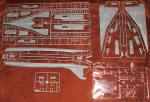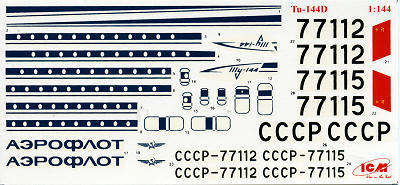
ICM 1/144 Tu-144D
| KIT #: | 14402 |
| PRICE: | $47.95 SRP |
| DECALS: | Two options |
| REVIEWER: | Scott Van Aken |
| NOTES: |

| HISTORY |
The Tupolev Tu-144 (NATO name: "Charger'") was a Soviet supersonic transport aircraft (SST) and remains one of only two SSTs to enter commercial service, the other being the Concorde. The design, publicly unveiled in January 1962, was constructed under the direction of the Soviet Tupolev design bureau, headed by Alexei Tupolev
The prototype first flew on 31 December 1968 near Moscow, two months before the first flight of the Concorde. The Tu-144 first broke the sound barrier on 5 June 1969, and on 15 July 1969 and became the first commercial transport to exceed Mach 2.
The Tu-144 was outwardly similar to the Concorde, under development at the same time by Aérospatiale/British Aircraft Corporation, and allegations were frequently made that Soviet espionage services had stolen Concorde technology. The Tu-144D was an improved version of the basic aircraft. It had upgraded engines that were more fuel efficient and allowed a range increase to 5300 kilometers. Five aircraft were so built.
The Tu-144 suffered a crash in 1973 at the Paris Air Show, delaying its development. The aircraft was introduced into passenger service on 1 November 1977, almost two years after the Concorde. In May 1978, another Tu-144 (an improved version, named Tu-144D) crashed in a test flight while being delivered, and the passenger fleet was permanently grounded after only 55 scheduled flights. The aircraft remained in use as a cargo plane until 1983, by which point a total of 102 commercial flights had been completed. The Tu-144 was later used by the Soviet space program to train pilots of the Buran spacecraft, and by NASA for supersonic research.
| THE KIT |
 The Tu-144 has been
available in the past in a couple of different scales, but not what many
consider to be the 'one true scale' for airliner models; 1/144. This is not a
small kit by any means measuring 465 mm in length (that is 18 1/3 inches), it
very much fills the box in which it is packed. However, it does not have a huge
wingspan so it comes in a long, somewhat skinny box with the instructions folded
inside.
The Tu-144 has been
available in the past in a couple of different scales, but not what many
consider to be the 'one true scale' for airliner models; 1/144. This is not a
small kit by any means measuring 465 mm in length (that is 18 1/3 inches), it
very much fills the box in which it is packed. However, it does not have a huge
wingspan so it comes in a long, somewhat skinny box with the instructions folded
inside.
Molding on the kit is just what one would expect from a modern kit. Nicely engraved panel lines that are not too deep on the medium grey sprues. ICM has also provided separate windows with clear bits to fit into them. I know that airliner modelers are split as to which method is better when it comes to windows. Some like this approach while others prefer the decal method with a slick fuselage. I have to admit that painting is quite a bit easier with the latter method as having to install windows pretty much requires one to prepaint the fuselage halves to prevent tedious masking of very small windows.
Other nice
features are a superbly detailed set of landing gear. The gear on these and
other airliners is often rather complex and that comes across well. Unlike many
planes, the main gear legs on this are to be canted a bit at the main junction,
an info sheet being added just to make sure you get this feature down well. The
other main feature is the ability to model the aircraft with the nose up for
flight or down for landing and ground operation. The Tu-144 also has retractable
canards and you can pose those as you wish. These were for improved low speed
handling so would be retracted during supersonic flight. The kit also includes a
display stand, something that is a bit of a rarity in most aircraft model kits,
though used in a larger percentage of airliner kits. The
 difference
between this and the original boxing are the engine exhaust and the wing tips.
Both of these areas will need to be cut away on the original plastic to make the
upgrades.
difference
between this and the original boxing are the engine exhaust and the wing tips.
Both of these areas will need to be cut away on the original plastic to make the
upgrades.
| CONCLUSIONS |
It is great to see ICM doing variants. I am not sure what they can come up with for another boxing, though perhaps they will choose the one brought back into service for NASA usage. Regardless, it is superbly molded, should fit quite well, will make a good size model and is of an interesting aircraft. It should look great set next to a Concorde.
| REFERENCES |
http://en.wikipedia.org/wiki/TU-144
July 2012
Thanks to Squadron Products for the preview kit. You can find this one at your local shop or have them order it for you
If you would like your product reviewed fairly and fairly quickly, please contact the editor or see other details in the Note to Contributors.